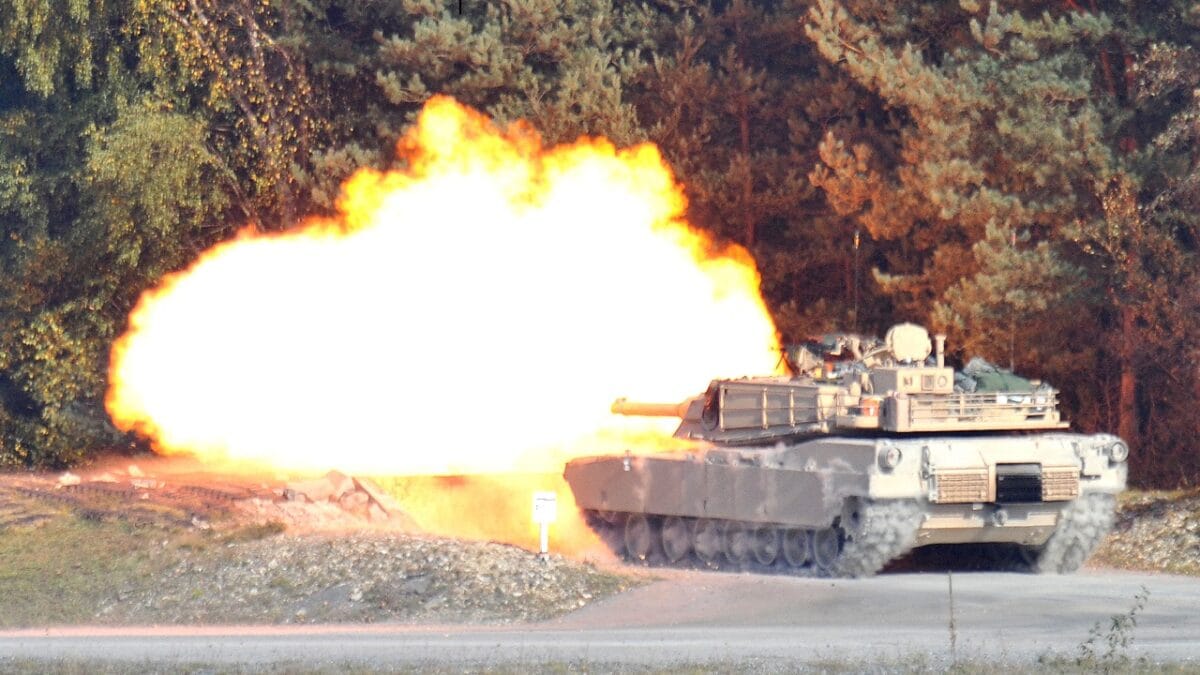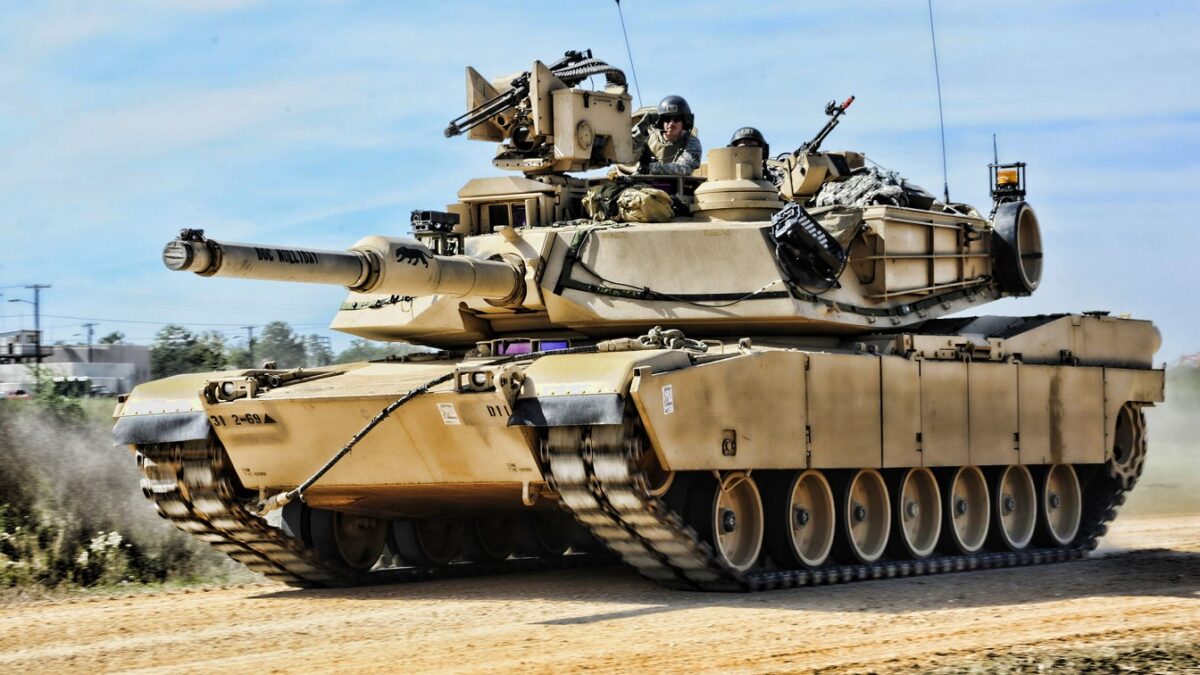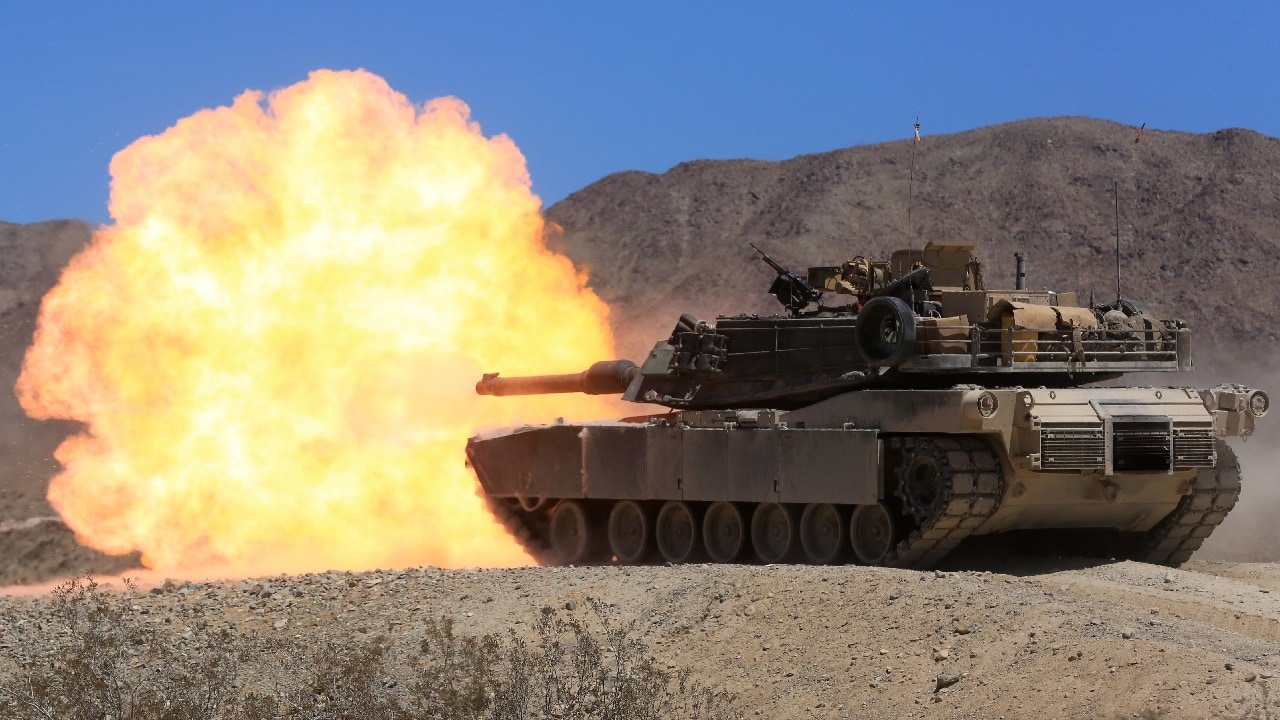Ukraine is getting America’s powerful Abrams tank—but generals disagree over how difficult it will be to operate – Berlin’s contorted decision-making process on whether to allow delivery of its widely-operated Leopard 2 tanks to Ukraine has been at the forefront of the news cycle in January as German Chancellor Scholz, and his officials issued contradictory messages regarding whether they would “release the Leopards.”
Fearing Russian escalation, Scholz seemingly conditioned authorization on Washington also donating its M1 Abrams main battle tanks to diffuse responsibility.
(Subscribe to Our YouTube Channel Here. 19FortyFive publishes original videos every day.)
Here Comes the M1 Abrams for Ukraine
Finally, on Tuesday (Jan. 24), Berlin announced it would donate a company of 14 Leopard 2A6 battle tanks with long-barreled guns to Ukraine and open the way for many additional donations from the Leopard’s numerous operators. But perhaps a quid-pro-quo was at work. The same day, word spread that U.S. President Joe Biden would announce he was sending 31 M1 Abrams tanks to Ukraine.
That could be the first tranche of a more significant transfer—as has proven the case for the Bradley fighting vehicle. Both the Leopard 2 and M1 Abrams are broadly comparable in performance—heavier at 60-70 tons, faster, harder-hitting, and with much better sensors than the 45-55 ton main battle tanks used by Russia and Ukraine. Both will require 2-3 months of training for Ukrainian crews and maintainers at minimum before deployment.
However, the M1 Abrams’ deployment amounts to a rapid about-face for Washington. Immediately prior, defense secretary Lloyd Austin dismissed the Abrams as too logistically demanding—“a very complicated piece of equipment”— compared to Germany’s Leopard 2.
This assertion spurred an online debate amongst senior retired officers, all vocal supporters of Ukraine with experience commanding M1 Abrams-equipped units.
Retired U.S. Lt. Gen. Mark Hertling, who has commanded everything from platoons to an entire armored division of Patton and Abrams tanks, supported Austin’s take, tweeting:
“Ukrainian Army commanders who I talk with want tanks, but have admitted they struggle with logistics, repair parts getting to the right places, and resupply. So reducing the burden must be a key consideration—and in my professional opinion, the Abrams would cause more of a burden due to training and resupply to a force that’s in a tough fight. Also, in my view, Leopard 2s would means less of a burden.”
But retired Australian general Mick Ryan, former commander of an Abrams brigade in arid northern Australia, argued such arguments were “… excuses … entirely absent when these tanks were sold to Iraq, Egypt and Australia – all of whom possess very light military logistic capabilities.”
Retired General Barry McCaffrey, commander of the 24th Infantry Division that destroyed Iraq’s 1st Armored Division at Rumaila in one day, also endorsed the Abrams, noting its integration by earlier foreign operators. “An experienced Ukrainian tank crew could fight in 30 days,” he concludesd.
And Lt. Gen. Ben Hodges, formerly chief of U.S. Army Europe, agreed the difficulties of adoption were exaggerated: “The Ukrainians will figure all of that out. Please no more condescension from DoD.”
But Hertling disagreed that withholding the M1 Abrams was a “political decision” and didn’t find the examples of non-U.S. Abrams operators persuasive. “Countries we’ve sold it to took years–and [U.S.] contractors—to field and sustain them.”
While it’s certain Ukraine will get both Leopard 2s and M1 Abrams, it’s still worth examination—just how serious were those downsides cited by Austin prior to the change?
Are there enough M1 Abrams and related support facilities available?
Broadly speaking, the U.S. has a staggering 3,700 Abrams tanks estimated to be in storage, according to IISS’s Military Balance 2021, and builds more yearly—even if the Army doesn’t want them—to keep the factory in Lima, Ohio open.
And the Marine Corps recently retired all of its 400+ M1A1 tanks. There are also 2,000-3,000 Leopard 2s in service or storage, though divvied up between numerous operating countries in a variety of models.
But there are 13 countries in/around Europe operating Leopard 2s, and only one—Poland—that just began operating the M1 Abrams. That means there’s a lot of Leopard 2 inventory, maintenance depots, and spare parts geographically close to Ukraine.
Still, there’s one other big Abrams operator in Europe—the U.S. Army. While U.S. armor in Europe briefly dwindled to zero in 2013, it ticked back up after Russia’s invasions of Ukraine in 2014 and 2022, notably including a rotating armor brigade in Poland.
MORE: Why Putin Fears the M1 Abrams Tank
MORE: I Went to War in the Leopard 2 Tank Ukraine Wants
MORE: World War III – Where Could It Start?
MORE: A U.S.-China War Over Taiwan Would Be Bloody
Dave Demorrow, a retired Army non-commissioned officer-in-charge with 18 year’s experience serving in mechanized units, particularly in an intelligence role, sparred online with Hertling regarding the availability of M1 hulls and spare parts in Europe.
Demorrow, who organizes donations of gear and equipment to Ukraine and runs a military museum in Texas, told me over the phone that besides the rotating brigade in Poland he believes there are 2-3 additional brigade-sets of M1s pre-positioned in Europe. He states, between that and Poland’s purchase of hundreds of M1s, there’s a healthy supply of spare parts. That could reflect unspecified “enhancements” the White House promised last year.
However, Major. Joe Minarick of the 278th Armored Cavalry Regiment of the Tennessee Army National Guard wrote to me that he “would not expect” the U.S. to dip into its pre-positioned assets, and that in his experience as a battlegroup planner in Poland, spare parts were an issue.
“[Many parts] have to be ordered from the U.S. When we were in Poland they would fly parts to Ramstein then truck them to an SSA yard in Poland, where we would have to drive and pick them up. The Ukrainian border would be an addition to this process, which in our case would take up to a few days.”
Is the M1 Abrams’s gas turbine engine incompatible with Ukraine’s armed forces?
The Leopard 2 relies on a diesel engine, like most Ukrainian tanks. The Abram employs a Honeywell AGT1500 gas-turbine engine that can run on jet fuel. But it’s a multifuel engine, so it can run on diesel too—and according to Demorrow, the U.S. Army service frequently does this when refueling alongside diesel-engine Bradley fighting vehicles.
“It could run on Chanel No. 5,” Demorrow said, alluding to a stunt pulled by comedian Jay Leno using his gas-turbine-powered Chrysler. Furthermore, Ukraine does deploy some gas-turbine engine tanks, the speedy T-80BV assigned to airborne brigades.
Joe Minarick concurred “The fuel is a non-issue. M1s are thirsty, but they’ll drink anything. Running diesel through the turbine slightly increases the maintenance burden (they prefer JP8 [kerosene-based jet fuel]), but it’s not much of an issue.”
The real problem is that the M1 Abrams’ faster starting and accelerating engine is a gas hog. Reportedly, an M1 consumes 10 gallons an hour idling and .6 to 1.2 gallons per minute on the move. For every mile traveled, a Leopard 2 consumes just over half as much. That’s obviously a big logistical burden.
“I hope to hell we give them good HEMMT fuelers as well,” Minarick remarked, referring to huge, eight-wheeled Heavy Expanded Mobility Tactical Trucks such as the M978 tanker which can carry 2,500 gallons.
Demorrow insists the fuel-efficiency gap is lower—“around 17 percent”—and believes Ukrainians will field-improvise external auxiliary power units (APUs) for M1 Abrams to avoid gas consumption while idling, a solution he says is harder to implement on the Leopard 2A4’s turret. Only the latest-model Abrams and Leopard 2A7s come with built-in APUs.
Will Ukraine get depleted uranium armor and weapons?
The U.S. M1s incorporate ultra-dense depleted uranium (DU) to maximize protection and firepower. A depleted uranium mesh weighing a few tons is inserted between steel or carbon plates to help Abrams’s front turret to achieve dramatically higher effective levels of armor protection, rendering parts of its front turret impenetrable to most armor-piercing weapons.
The Army also uses hi-tech M829 depleted uranium shells tailored to defeat sophisticated Kontakt-5 and Relikt explosive reactive armor on newer Russian tanks – which may use depleted uranium shells, but don’t sport depleted uranium armor.
Depleted uranium is mildly radioactive, and the U.S. has omitted it from Abrams tanks exported to operators like Egypt and Thailand, leaving them with reduced armor protection. However, the ban isn’t absolute; Poland and possibly Australia’s M1s will have depleted uranium armor inserts and M829 rounds.

U.S. Army soldiers of Alpha Company, 3rd Battalion 66th Armor Regiment, Task Force 1-2, 172nd Infantry Brigade conduct a live fire training exercise with M1 Abrams tanks, on Range 132 at Grafenwoehr Training Area, Germany, Oct. 13, 2010.
Thus it’s unclear whether Ukraine’s M1s will benefit from the controversial material. Meanwhile, later-model Leopard 2A5s, 2A6s and 2A7s sport extra armor and longer-barreled guns to match the benefits depleted uranium provide the M1.
Demorrow argued that the secrecy concerns surrounding DU armor were overblown decades after its introduction. “I think it’s more about radiation rather than it’s a strategic or tactical secret.”
Furthermore, he argues the M1s are robust even without depleted uranium reinforcement. Present at the titanic Battle of Norfolk in the 1991 Gulf War, he was driving an ammunition truck close to an M1A1 Abrams—an earlier model lacking uranium armor—when it was repeatedly hit by friendly fire from forces advancing behind it. It sustained a dozen hits before finally being disabled, with three of the four crew surviving.
M1 Abrams: Training and sustainment
There are also concerns the M1’s advanced components will make it difficult to train personnel to operate and sustain it in the field. Nicholas Drummond, a British armor officer and advisor to German tank manufacturer KMW told Breaking Defense the Leopard 2 may be easier to integrate due to being designed for Germany’s Cold War conscript army.
Hertling tweeted the Abrams requires higher training standards than most tanks, especially for the crew to avoid self-inflicted mechanical breakdowns:
“Some M1 repairs require part replacements (requiring many high tech spare parts to be in a Prescribed Load List [a standardized unit inventory of on-hand spare parts]). Other replacements require pulling things (like Full Up Power Packs [engine and transmission], sights, etc.) to a logistics center/depot with new one being sent forward. It’s a 500-mile supply line from Poland to the Donbas.”
Minarick, who has 24 year’s experience with armor, agreed that Leopard 2s are easier to maintain than the Abrams. “The turbine is more complicated (although having fewer moving parts) than a diesel engine. From having worked with both platforms in the field, the reliability is about the same, only the repairs are more difficult.”
Demorrow, however, argues there’s a double-standard, noting M2s and Bradley fighting vehicles already given to Ukraine use Bushmaster cannons with more components than the Abram’s main gun, and use the same support systems including M88 Armored Recovery Vehicles. He maintains faulty power packs could be shipped out of Ukraine while the vehicles stays in country using a swapped-in pack.
Diverging views among officers
Why have these veterans come to such different conclusions despite their common experience with the Abrams? Perhaps, they have different assumptions of the integration and opportunity costs.
Major General Patrick Donahoe—recently retired from his role overseeing maneuver warfare training at Fort Benning—argues, “[Ukrainian forces] need one system, delivered in numbers that matter, in one variant to east sustainment in order to maximize the effect on the enemy and reduce internal friction and challenges.”
From his perspective, giving two different tank models is worse than maximizing the delivery of the most efficient type.

M1 Abrams Tank. Image Credit: U.S. Army.
Responding to news of M1 deliveries, Hertling reiterated his concerns: “… can they quickly learn the capability of the Abrams (and Leopard II) the way it is designed to operate? That’s training with other tanks, infantry, scouts, drones, artillery, engineers, intel. All more than crew training when the tank – or small critical parts in the tank – break (which they do), and when those small and large replacement parts need replacing, and when it requires daily/weekly/monthly echelon maintenance, will Ukraine have also trained those who do these things?
After the tank crews, sections, companies, battalions master the gunnery skills, the maneuver, and the maintenance; will there also be echelons of support that will flow the needed parts, Full Up Power Packs, ammo, fuel, roadwheels, torsion bars, etc., etc., to the front lines?…I’ve seen U.S. units at our training centers and in combat get just a few things wrong and it causes disaster and failure. Lethal tanks turn into pillboxes that don’t move or shoot.”
So Hertling sees a distinction between simply operating a tank, and employing it sustainably and effectively using U.S.-style combined arms doctrine and logistics.
Ukraine’s military has undeniably absorbed a staggering variety of troop-carrying vehicles and artillery systems via foreign assistance—diversity ordinarily seen as a massive no-no to logisticians due to the inefficiencies of having to train for and sustain so many different types of equipment. If you assume there are substantial overhead costs to inducting new equipment types and constrained ‘bandwidth’ to do so, there’s less benefit to furnishing two types just to increase volume.
But boosters of the M1 Abrams for Ukraine argue Kyiv would gladly take all the tanks it can get and has the personnel, motivation, and culture of assimilation to adopt new platforms faster via crash courses and MacGyver-style fixes than a peacetime army ordinarily could. By keeping foreign experts on-call for technical consulting, and rapid on-demand parts deliveries, they argue Ukraine may sustain a diversified force better than is conventionally thought possible.
Mick Ryan writes: “Ukrainians have demonstrated throughout this war that they are very capable of integrating very complex hardware and weapons quickly. They are an adaptive, learning institution with a strong imperative for constant improvement.”
Furthermore, Ryan and defense expert Michael Kofman argue that while Ukraine can learn much from U.S. maneuver doctrine, the methods contextually suited to Ukraine may differ greatly.
Minarick, who considers Leopard 2s and M1 Abrams to be similar “apex tanks,” wrote to me: “Other countries far less competent have used them in austere environments. I think the concern that the Abram specific logistics will distract from more pressing issues on the ground is genuine, but overblown.”
Expertise and Experience: Sébastien Roblin writes on the technical, historical, and political aspects of international security and conflict for publications including The National Interest, NBC News, Forbes.com, War is Boring and 19FortyFive, where he is Defense-in-Depth editor. He holds a Master’s degree from Georgetown University and served with the Peace Corps in China. You can follow his articles on Twitter.

